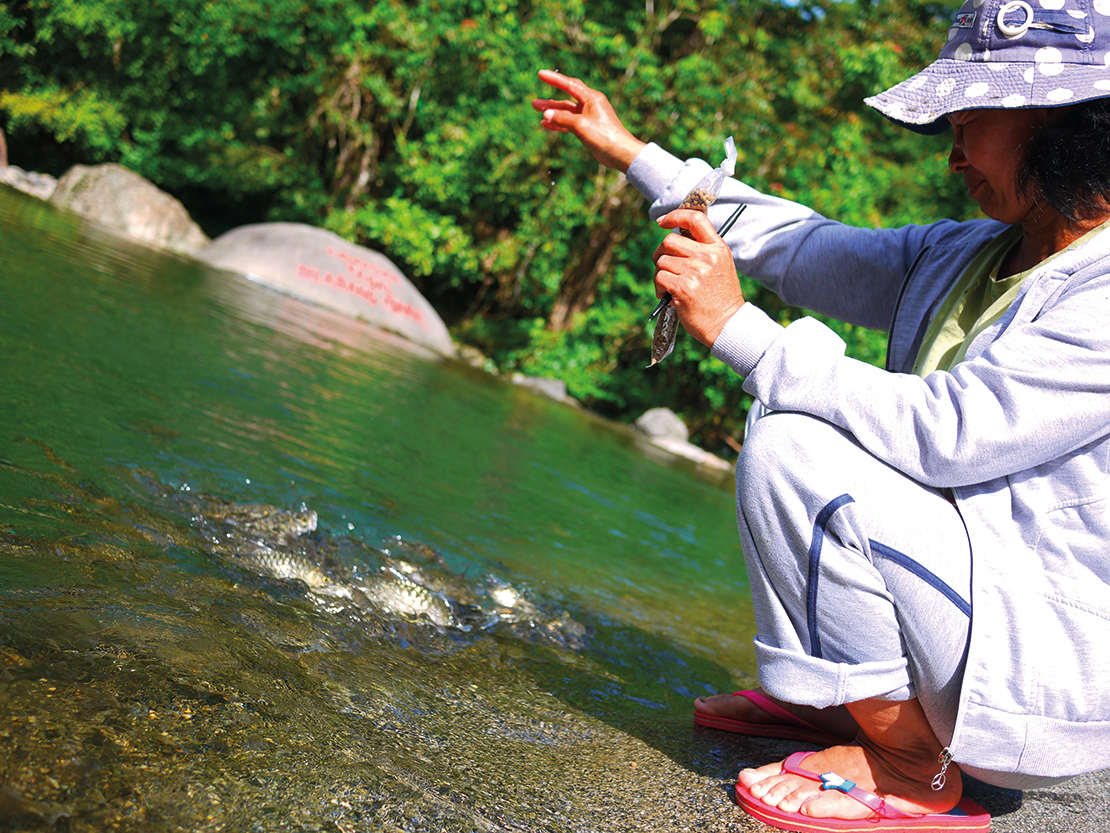
Target 6: Sustainable management of aquatic living resources
By 2020 all fish and invertebrate stocks and aquatic plants are managed and harvested sustainably, legally and applying ecosystem based approaches, so that overfishing is avoided, recovery plans and measures are in place for all depleted species, fisheries have no significant adverse impacts on threatened species and vulnerable ecosystems and the impacts of fisheries on stocks, species and ecosystems are within safe ecological limits.
Key messages
- Globally, small-scale marine and inland fisheries employ over 90 per cent of fishers and fishworkers and contribute nearly 50 percent of the total fish catch.
- Small-scale fisheries have less bycatch, use less destructive gear, and consume less fuel than industrial fisheries.
- Despite evidence that community resource governance can reduce or reverse degradation, the roles of IPLCs continue to be undervalued and marginalised.
- A radical transformation in governance, which secures the rights and customary practices of IPLCs and promotes co-management of resources by small-scale fishers, is required to protect and restore fish and invertebrate stocks and aquatic plants.
Significance of Target 6 for IPLCs
About one third of marine stocks are overfished, and the proportion of both marine and inland fish stocks that is exploited unsustainably continues to grow.1 This is in spite of the fact that an increasing percentage of marine fisheries, accounting for about 15 per cent of wild-caught seafood, is certified under a standard that recognises progress towards sustainable management.2 Less attention has been paid to freshwater fisheries which, importantly, account for about 40 per cent of all fish destined for human consumption.

The community fishing area of Kampung Melangkap Tiong. Credit: Alice Mathew.
Unsustainable fisheries—especially industrial fisheries—threaten marine and coastal biodiversity severely, and therefore they threaten the food security and ways of life of IPLCs, including most of the 800 million people worldwide who depend on fishing or small-scale fisheries for their food and livelihoods.3
Small-scale fisheries tend to be more sustainable because they have less bycatch, use less destructive gear, and consume less fuel.4 However, the scale of their contributions and their potential role in global sustainable fisheries production are insufficiently recognised and supported, and small-scale fishers continue to be marginalised, particularly when facing large-scale fisheries; coastal and upstream industries; reclamation projects; ports; and dams.5
Small-scale fisheries contribute nearly 50 per cent of the global fish catch, almost all of which is for direct human consumption, and employ over 90 percent of the world’s fishers and fishworkers.6
Women represent 14 per cent of fishers and hold 60–90 per cent of fish-processing jobs,7 making a critical contribution to the nutrition of more than three billion people. However, women are often excluded from consultation processes in the mainstream fisheries industry and they remain vulnerable to marginalisation, poverty and insecure resource rights.8
To make progress towards Target 6 and the SDGs, it is imperative that the central role of small-scale fishers, including IPLCs and women, in the sustainable management of aquatic resources is recognised.
Contributions and experiences of IPLCs towards Target 6
IPLCs are increasing their contributions to Target 6 both by revitalising and strengthening customary sustainable practices; through collaboration and shared governance schemes with scientists and government institutions; and by progressing the recognition of the rights and interests of small-scale fishers.
- In the Asia-Pacific region, a very active network of locally managed marine areas (LMMAs) has emerged. An LMMA is defined as “an area of nearshore waters that is actively being managed in a ‘local’ practitioner context by residing or neighbouring communities and/or families, or being collaboratively managed by both resident communities and local government representatives based in the immediate vicinity.” Typically, they involve the creation of no-take areas (community marine protected areas) and restrictions on fishing equipment, species or seasons in order to improve sustainability or increase overall yields.
- In Costa Rica, responsible marine fishing areas (RMFAs) take a similar approach.9 In an RMFA, the government and local fishing communities work together to agree rules and decisions related to responsible fishing, and co-develop a fisheries management plan. The first RMFA was recognised in 2009. In 2019 there were eleven formally recognised RMFAs and two more had been requested. All RMFAs are linked through a national network, which aims to implement the FAO’s Voluntary Guidelines for Securing Sustainable Small-scale Fisheries in the Context of Food Security and Poverty Eradication (the SSF Guidelines)10. The network also facilitates sharing of experiences and lessons learned; monitors and promotes the generation of knowledge that incorporates both traditional and scientific knowledge; and implements a human-rights-based approach to marine conservation.
- In Zanzibar, the village of Kukuu on Pemba Island is one of many villages that has established a permanent no-take zone within a wider area that is subject to a temporary fishing closure, which is in turn part of the 1,000-square-kilometre Pemba Channel Conservation Area. These measures are designed to protect the villagers’ lucrative octopus fisheries and ensure sustainable use, and are supported by the Mwambao Coastal Community Network (a local NGO).11 Mwambao collaborates with the government to improve fishery management and secure the future for local people and for the rich biodiversity of the area, which includes mangroves, seagrass beds and coral reef. It has played a key role in introducing and facilitating the implementation of the SSF Guidelines in Tanzania.12
- In Madagascar, since 2015 Fanamby (an NGO working with local community organisations) has been monitoring the marine protected area of Loky Manambato, which has 15,000 hectares of coral reefs and eight archipelagos. Ten rangers from the local communities patrol the sea throughout the year to make sure that season closures and core marine protected areas are respected. In 2018, 400 fishermen from four village pilot sites began monitoring their catches of fish and octopus. These fishermen are members of five associations which are all involved in elaborating the Dina (local communities’ laws, which are recognised at the national level).13

An octopus hunter searches for octopus in the clear waters of the lagoon off Bwejuu in Zanzibar, Tanzania. Credit: Tommy Trenchard.
IPLCs also contribute to sustainable management of fish and other aquatic resources in inland waters such as rivers, lakes and streams. For example:
- In Cambodia, over 500 community fisheries institutions cover an area of over 850,000 hectares and with some 188,000 members, including over 61,000 women. Registration of a community fisheries institution requires the development of internal rules and regulations based on a calculation of sustainable yields. In 2012, an evaluation of 450 community fisheries institutions documented teeming fish stocks and real benefits to local people in terms of raised standards of living.14
- In Nepal, the Kirant indigenous peoples protect lakes and wetlands through a focus on language, cultural, religious and spiritual values.15 The protection of the sacred lake Shalpa Pokhari in Bhojpur province, while benefiting from a multi-stakeholder approach, is based on an ancient intangible heritage that emphasises the spiritual aspects of diverse habitats, including the wetlands’ birds, frogs and wildlife in the wider ‘Himalayan Sacred Landscape’.16
- In Indonesia, Sasi is a 400-year-old traditional conservation system and natural resource management concept applied to both terrestrial and aquatic resources; it is effective in regulating the use of resources in indigenous communities, and solving conflicts and protecting vulnerable groups such as women and children, particularly widows and orphans. In the Haruku community where Sasi has been used, community regulations have been put in place to implement customary laws and traditional knowledge for a more sustainable use of natural resources and lands owned by the community, including inland and coastal waters, and to successfully protect the community’s territory through collective and united action against development projects pushed forward by powerful external actors.17
- In Sabah, Malaysia, the customary tagal system, a sustainable system for inland fisheries, has received government recognition in recent years (see Box 10).
Box 10: Alice Mathew and Jawatankuasa BioBudaya Melangkap
Case study: The community-based tagal system in Sabah, Malaysia
Tagal means prohibition in the Dusun language, and has been practised by the indigenous peoples of Sabah for many generations. It involves shared responsibilities and management, not only for rivers but also for other natural resources. This traditional concept has been adopted by the Sabah Fisheries Department and about 400 river co-management systems have now implemented the tagal concept.
— Read the full case study

A child plays with fish in Sabah. The Melangkap community protocol has been used to establish equal sharing of benefits from ecotourism. Credit: Lano Lan.
In some cases, IPLCs are also addressing the decline in fisheries and aquatic biodiversity using an integrated rights-and-ecosystem approach. This is particularly well exemplified by the case study from the Pacific Northwest in the United States (see Box 11). Successful IPLC projects related to salmon have also been reported elsewhere, including Arctic Finland, where Saami people are rewilding salmon in the Näätämö River18, and the Kamchatka Peninsula in the Russian Federation (Box 3).
Box 11: Preston Hardison, Tulalip Natural Resources Treaty Rights Office
In 2014, tribes led the way for dismantling the Glines Canyon Dam on the Elwha River, the largest dam removal in US history, and they are working to remove others. Credit: J Daracunas.

Case study: Tribes address salmon declines in the US Pacific Northwest
The Pacific salmon is a cultural keystone species for many indigenous peoples of the West Coast of Canada and the United States. Salmon are our relatives, central to our histories, identities, stories, expressions, culture and economies. We honour them every year with the first salmon ceremony, through which we communicate with the salmon people in order to renew our relations.
— Read the full case study
Opportunities and recommended actions
- IPLC fishers should continue to assert and renew their customary tenure rights and relationships to waters and aquatic living resources, and expand their local, regional and global contributions and solutions towards sustainable aquatic ecosystems.
- Governments and all relevant actors should formally recognise IPLC fishers’ traditional tenure and customary rights to aquatic resources as a matter of urgency, consistent with a human-rights-based approach to fisheries management and conservation, including through upscaling of implementation of the FAO Voluntary Guidelines for Securing Sustainable Small-Scale Fisheries (the SSF Guidelines).
- Governments should reform policy and legislation, with the full and effective participation of IPLCs, to recognise and support their role in sustainable fisheries and in managing aquatic resources, and grant IPLC fishers preferential access for fishing in waters under national jurisdiction. This includes recognising and supporting the role of women and youth.
- Governments and relevant actors should fully implement the ecosystem approach, addressing linkages between terrestrial and marine ecosystems and synergies between sustainable aquatic resources and the SDGs.
- Governments should reduce subsidies that contribute to overfishing and overcapacity, and redirect investments to sustainable small-scale fisheries and community-managed and community-conserved aquatic areas.

Indigenous Moken children swimming off the coast of Mu Ko Surin island, Thailand. Credit: Andrew Testa.
Key resources
- Food and Agriculture Organization of the United Nations (2015) Voluntary Guidelines for Securing Sustainable Small-Scale Fisheries in the Context of Food Security and Poverty Eradication. Rome: FAO. Available at: http://www.fao.org/documents/card/en/c/I4356EN
- International Collective in Support of Fishworkers: https://www.icsf.net/en/page/588-About%20ICSF.html
- Harper, S., Zeller, D., Hauzer, M. Pauly, D. and Sumaila, U. R. (2013) ‘Women and fisheries: Contribution to food security and local economies’, Marine Policy 39(1), pp. 56–63. Available at: https://doi.org/10.1016/j.marpol.2012.10.018.
- The LMMA (Locally Managed Marine Area) Network: http://lmmanetwork.org/
References
- Food and Agriculture Organization of the United Nations (2019) Tracking progress on food and agriculture-related SDG indicators. Rome: Food and Agriculture Organization. Available at: http://www.fao.org/sdg-progress-report/en
—
ETC Group (2017) Who will feed us? The Industrial Food Chain vs. The Peasant Food Web, 3rd Edition. ETC Group. Available at: http://www.etcgroup.org/sites/www.etcgroup.org/files/files/etc-whowillfeedus-english-webshare.pdf - Convention on Biological Diversity (2020) Global Biodiversity Outlook 5. Montréal: Convention on Biological Diversity.
- Pedersen, C., Feodoroff, T., Reuter, R., Franco, J., Buxton, N., Barbesgaard, M. C. and Vervest, P. (2014). The global ocean grab: A primer. Various: Transnational Institute, Argrarian Justice Programme, Masifundise Development Trust and Afrika Kontakt together with World Forum of Fisher Peoples. Available at: https://www.tni.org/files/download/the_global_ocean_grab.pdf
—
McCauley, D. J., Pinsky, M. L., Palumbi, S. R., Estes, J. A., Joyce, F. H. and Warner, R. R. (2015) ‘Marine defaunation: Animal loss in the global ocean’, Science 347(6219). - Balvanera, P., Pfaff A. et al. (Draft) ‘Chapter 2: Status and trends; indirect and direct drivers of change’, in The Global Assessment Report on Biodiversity And Ecosystem Services. Bonn: IPBES.
- Balvanera, P., Pfaff A. et al. (Draft) ‘Chapter 2: Status and trends; indirect and direct drivers of change’, in The Global Assessment Report on Biodiversity And Ecosystem Services. Bonn: IPBES.
—
International Collective in Support of Fishworkers (n.d.) About ICSF. Chennai and Amsterdam: International Collective in Support of Fishworkers. Available at: https://www.icsf.net/en/page/588-About%20ICSF.html - Food and Agriculture Organization of the United Nations (2014) The State of world fisheries and aquaculture: Opportunities and challenges. Rome: Food and Agriculture Organisation of the United Nations. Available at: http://www.fao.org/3/a-i3720e.pdf
—
Committee on World Food Security and the Food and Agriculture Organization of the United Nations (2012) Voluntary Guidelines on the Responsible Governance of Tenure of Land, Fisheries and Forests in the Context of National Food Security. Rome: Food and Agriculture Organization of the United Nations. Available at: http://www.fao.org/3/a-i2801e.pdf - Monfort, M. C. (2015) The role of women in the seafood industry. Rome: Food and Agriculture Organization of the United Nations. Available at: http://www.fao.org/3/a-bc014e.pdf
- Harper, S., Zeller, D., Hauzer, M. Pauly, D. and Sumaila, U. R. (2013) ‘Women and fisheries: Contribution to food security and local economies’, Marine Policy 39, pp. 56-63. Available at: https://doi.org/10.1016/j.marpol.2012.10.018
- A responsible marine fishery area (RMFA) is defined as: “An area with significant biological, fisheries or sociocultural characteristics that is delimited by geographical coordinates and other mechanisms, where fishing activity is regulated in a way that secures the long-term sustainability of fisheries, and where, INCOPESCA can rely on the support of coastal communities and/or other institutions for fisheries conservation, use and management”. Decree no. 35502-MAG (2009), Art. 1a., El DE Presidente La República Y El Ministro De Agricultura Y Ganadería (2018) DECRETO No 35502-MAG. Available at: https://www.cbd.int/doc/c/355d/0a41/eebcef42eca5b780744a7fc3/mcb-em-2018-01-costarica-submission3-es.pdf
- Food and Agriculture Organization of the United Nations (2015) Voluntary Guidelines for Securing Sustainable Small-Scale Fisheries in the Context of Food Security and Poverty Eradication. Rome: Food and Agriculture Organization of the United Nations. Available at: http://www.fao.org/documents/card/en/c/I4356EN
- Slade, L. (2018) ‘Mwambao Coastal Community Network’, Samudra.79, p.50, International Collective in Support of Fishworkers (ICSF) Trust. Available at: https://www.icsf.net/images/samudra/pdf/english/issue_79/269_Samudra_79_August_2018.pdf
- Food and Agriculture Organization of the United Nations (2015) Voluntary Guidelines for Securing Sustainable Small-Scale Fisheries in the Context of Food Security and Poverty Eradication. Rome: Food and Agriculture Organization of the United Nations. Available at: http://www.fao.org/3/i4356en/I4356EN.pdf
- Fanamby (2019) Annual report for 2018 for project ‘Promoting Diverse Cultural Values of Biodiversity and Ecosystem Services’. Antananarivo: Fanamby.
- Kurien, J. (2019) Cambodia – fishery rights: From individual rights to community commons. Samudra Report 80. Chennai and Amsterdam: International Collective in Support of Fishworkers. Available at: http://aquaticcommons.org/26123/
- Rai 2018, Indigenous peoples and local communities. In 25 years of achievements on biodiversity conservation in Nepal. Government of Nepal, Ministry of Forest and Soil Conservation and Environment.
- Rai, K. (2005) Culture, Religious and Spiritual Values of Salpa Pokahri. Department of National Parks and Wildlife Conservation, Ministry of Forests and Environment, Government of Nepal and World Wildlife Fund Nepal.
—
Dhakal, M., Lamichhane, D., Ghimire, M. D., Poudyal, A., Uprety, Y., Svich, T., Pandey, M. (eds) (2018) 25 Years of Achievements on Biodiversity Conservation in Nepal. Environment and Biodiversity Division, Ministry of Forests and Environment, Government of Nepal. Available at: http://mofe.gov.np/downloadsdetail/6/2018/67362203/ - Hong, H., Xiuping, M. & Kissya, E. with Yanes. (2010) Indigenous knowledge and customary law in natural resource management: Experiences in Yunnan, China and Haruku, Indonesia. Asia Indigenous Peoples Pact Foundation.
—
See also: International Land Coalition and AMAN (n.d.) Sasi, a traditional natural resource conservation and management system. Rome and Jakarta: International Land Coalition and AMAN. Available at: https://d3o3cb4w253x5q.cloudfront.net/media/documents/ILC_Case_Study_0145__Indonesia_EN.pdf - Quinn, E. (2019) ‘What a Saami-led project in Arctic Finland can teach us about indigenous science’. Montreal: Eye on the Arctic. Available at: https://www.rcinet.ca/eye-on-the-arctic/2019/02/11/what-a-saami-led-project-in-arctic-finland-can-teach-us-about-indigenous-science/


